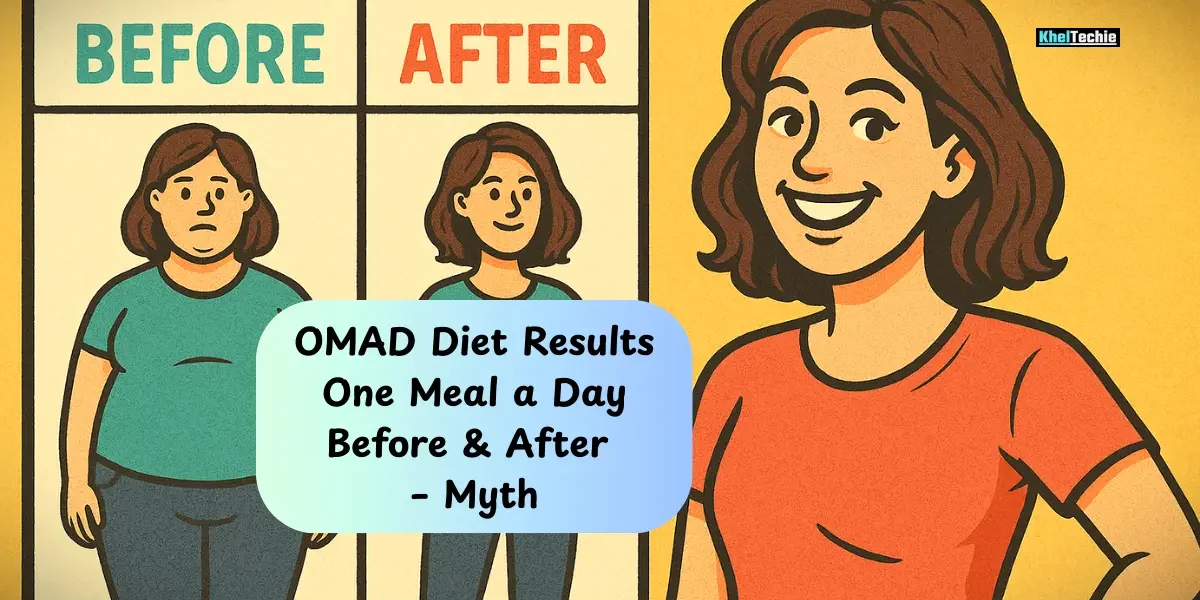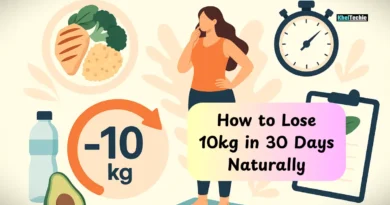OMAD Diet Results: One Meal a Day Before & After – Myth
Why Are People Talking About OMAD Diet Results?
You’ve probably seen the headlines, “Lose 30 pounds in 2 months!” or “How I Boosted My Energy with Just One Meal a Day.” These are real stories from people who tried the OMAD diet (One Meal a Day) and saw dramatic results.
But what’s behind these OMAD diet before and after transformations? Is it sustainable? Healthy? And most importantly will it work for you?
In this article, we’ll dive deep into OMAD diet results, including real-life case studies, expert-backed advice, common mistakes to avoid, and answers to the most frequently asked questions about this popular intermittent fasting protocol.
Also read – Millets for Weight Loss

What is OMAD Diet Results: One Meal a Day Before & After?
Let’s break it down.
The OMAD diet stands for One Meal A Day. It’s an extreme form of intermittent fasting where you eat all your daily calories within a single meal window, usually lasting one hour. The rest of the day is spent fasting.
When people talk about OMAD diet results before and after, they’re referring to the physical, mental, and metabolic changes experienced by individuals who have followed this eating pattern consistently over weeks or months.
“OMAD is like rebooting your eating habits with a strict reset button, less snacking, more discipline, faster results.”
Think of it like this, imagine shrinking your entire food intake into one concentrated time slot like compressing a whole movie into a trailer but still getting the full story.
Why OMAD Diet Results Matter
The OMAD diet has surged in popularity, especially among those looking for rapid weight loss without counting every calorie. But why should you care about OMAD results?
Here’s what the data says:
- According to a 2020 study published in The New England Journal of Medicine, time-restricted eating can lead to significant weight loss over 12 weeks.
- While not directly about OMAD, the research supports the broader category of intermittent fasting, which OMAD falls under.
- Many anecdotal reports suggest that people lose between 10–30 pounds in 2–3 months on OMAD, depending on their starting point and adherence.
But beyond the numbers on the scale, OMAD results often include:
- Increased energy levels
- Improved mental clarity
- Reduced inflammation
- Lower blood sugar levels
However, it’s not just about the positives. There are also concerns around nutrient deficiencies, hunger pangs, and sustainability, more on that later.
Step-by-Step Guide to Seeing OMAD Diet Results
If you’re considering trying OMAD, here’s how to do it effectively and safely.
Step 1: Set Realistic Expectations
Before diving in, ask yourself:
- What’s your goal? Weight loss, improved focus, better digestion?
- Are you prepared for lifestyle changes?
- Do you have any medical conditions that might be affected by fasting?
Start with a less restrictive version of intermittent fasting (like 16:8) to ease into OMAD.
Step 2: Choose Your Meal Window
Most people pick a 1-hour window in the late afternoon or early evening. For example:
- 5:00 PM – 6:00 PM
This gives your body ample time to fast while allowing you to enjoy your meal when you’re most social and relaxed.
Step 3: Plan Nutrient-Dense Meals
Since you only eat once a day, every bite counts.
Your OMAD meal should include:
| Macronutrient | Food Sources |
|---|---|
| Protein | Chicken, fish, eggs, tofu, Greek yogurt |
| Fats | Avocado, olive oil, nuts, seeds |
| Carbs | Sweet potatoes, quinoa, brown rice, vegetables |
🍽️ Example OMAD Meal:
- Grilled salmon (protein + healthy fats)
- Quinoa and roasted veggies (complex carbs + fiber)
- Mixed greens salad with olive oil dressing (vitamins + minerals)
Step 4: Stay Hydrated
Drink plenty of water, herbal teas, black coffee, and electrolyte-rich drinks during your fasting window. Dehydration can mimic hunger!
Step 5: Track Progress
Use tools like:
- Scale and body fat percentage monitor
- Blood pressure and glucose monitors
- Mood and energy logs
- Before-and-after photos
Take weekly photos in the same clothes and lighting to visually track changes.
Step 6: Listen to Your Body
If you feel dizzy, weak, or overly hungry, consider adjusting your plan. OMAD isn’t one-size-fits-all.

Common Mistakes to Avoid on OMAD Diet
Even if you follow the steps above, many people make critical errors that sabotage their OMAD results before and after.
1- Eating Junk During Your Meal Window
Just because you eat once a day doesn’t mean you should binge on pizza and ice cream. That defeats the purpose.
✅ Fix: Prioritize whole foods and balanced macros.
2- Skipping Electrolytes
Fasting increases sodium excretion. Without enough electrolytes, you may experience fatigue, headaches, or muscle cramps.
✅ Fix: Add a pinch of sea salt to water or drink bone broth during fasting.
3- Ignoring Hunger Signals
Some discomfort is normal at first, but severe hunger could signal inadequate calorie intake.
✅ Fix: Adjust your caloric intake based on BMR (Basal Metabolic Rate).
4 – Not Giving It Time
OMAD results don’t happen overnight. Give your body at least 4–6 weeks to adapt.
✅ Fix: Be patient and consistent.
5 – Overtraining on OMAD
Working out intensely while fasting can drain energy and lead to burnout.
✅ Fix: Stick to light exercise like walking, yoga, or moderate strength training.
For Real OMAD Diet Results: Before & After Stories Visit
Let’s look at some real-life examples of people who followed the OMAD diet.
- Quora Community – How many pounds can I lose with an OMAD diet in a month?
- Reddit Community – r/omad
OMAD Diet Pros and Cons Summary
| Pros | Cons |
|---|---|
| Rapid weight loss potential | Risk of nutrient deficiency |
| May improve insulin sensitivity | Not sustainable for everyone |
| Saves time and money on meals | Possible fatigue or irritability |
| Can boost mental clarity | May cause digestive issues |
| Encourages mindful eating | Not recommended for certain health conditions |
Final Thoughts: Is OMAD Right for You?
OMAD diet results before and after can be impressive, but they depend heavily on your commitment, dietary choices, and individual physiology.
If you’re looking for a short-term reset or a way to break through a weight loss plateau, OMAD might be worth trying. However, if you prefer balanced meals throughout the day or have underlying health conditions, it may not be the best fit.
Remember, results come from consistency, not perfection.
Your Turn!
Have you tried OMAD? Share your before and after story in the comments below! Or if you’re curious but unsure, let us know what questions you still have, we’re here to help.
📌 Don’t forget to share this guide with someone who’s thinking about trying OMAD. Knowledge is power and so is support!
Disclaimer: This article is for informational purposes only and not intended as medical advice. Always consult a healthcare professional before making drastic dietary changes.
Frequently Asked Questions
How Long Does It Take to See OMAD Diet Results?
Most people start noticing small changes within 2–4 weeks, including reduced bloating, more energy, and slight weight loss. Significant results (like 10+ lbs lost) typically appear after 6–12 weeks.
Can You Lose Weight Fast on OMAD?
Yes, many people report rapid weight loss due to reduced calorie intake and increased fat burning during fasting. However, results vary based on metabolism, activity level, and diet quality.
Is OMAD Safe for Everyone?
No. OMAD may not be suitable for:
- Pregnant or breastfeeding women
- Individuals with diabetes (without medical supervision)
- Those with a history of eating disorders
Always consult a healthcare provider before starting OMAD.
Do You Need Supplements on OMAD?
While not mandatory, some people benefit from:
- Multivitamins
- Magnesium
- Vitamin D
- Omega-3s
Because you’re eating less frequently, it’s harder to get all nutrients from food alone.
What Should You Eat on OMAD?
Prioritize:
- Lean proteins
- Healthy fats
- Complex carbohydrates
- Fiber-rich vegetables
Avoid processed foods, sugary snacks, and refined carbs.
Will OMAD Cause Muscle Loss?
Only if you’re not consuming enough protein. Aim for 0.8–1 gram of protein per pound of body weight in your meal.
Can You Exercise on OMAD?
Yes, but choose low-intensity workouts like:
- Walking
- Yoga
- Light resistance training
Avoid heavy lifting or HIIT until your body adapts.
How Do You Deal With Hunger on OMAD?
Try:
Keeping busy with hobbies or work
Drinking black coffee or tea
Sipping on lemon water
Practicing mindfulness or meditation
What If OMAD Isn’t Working for Me?
Consider switching to a less restrictive fasting schedule (e.g., 18:6 or 16:8). Also, evaluate your nutrition, sleep, and stress levels.
Are OMAD Before and After Photos Reliable?
Many are genuine, but always check the source. Look for posts that include context like starting weight, duration, and other lifestyle changes.




